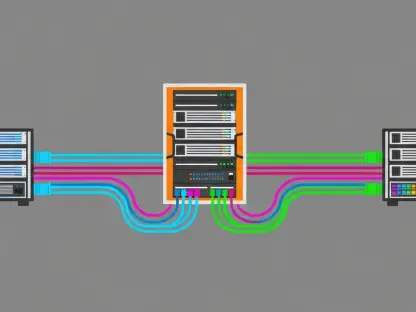In the 2002 sci-fi film “Minority Report,” predictive technology is used to prevent crimes before they happen. Similarly, in the financial world, CFOs and treasurers are leveraging advanced data analysis and risk management tools to ensure financial stability and growth. The increasing adoption of The Clearing House’s RTP® instant payments network each month highlights the merging of real-time payments and real-time financial data as a pivotal change for finance professionals.
Proactive Risk Management
CFOs today are akin to the PreCrime division in “Minority Report,” continuously analyzing data to make risk-informed decisions. They must mitigate various risks such as credit risks, market volatility, and operational inefficiencies. By leveraging real-time data, CFOs can proactively manage these risks, ensuring financial stability and growth. The ability to foresee potential disruptions allows CFOs to not just navigate but thrive in the complex financial landscape.
Continuous Data Analysis
The continuous analysis of real-time data allows CFOs to stay ahead of potential financial threats. This proactive approach is essential in today’s fast-paced financial environment, where delays in decision-making can lead to significant losses. Real-time data provides the necessary insights to make informed decisions quickly, reducing the likelihood of financial disruptions. With instantaneous feedback loops, CFOs can adjust strategies on the fly, thus preventing minor issues from escalating into substantial problems.
By having real-time access to critical information, CFOs can deploy resources more strategically, anticipating market shifts and preparing countermeasures in advance. This capability is invaluable for maintaining investor confidence and securing long-term financial health. Investors and stakeholders increasingly expect transparency and agility from organizations, and real-time data furnishes the tools needed to meet these expectations. Ensuring this level of preparedness is what sets apart high-performing firms in the highly competitive financial sector.
Role of Real-Time Data in Treasury Management
The integration of real-time data significantly enhances liquidity performance. Traditional liquidity management relied on batch processing and historical data, often leading to reactive measures. In contrast, real-time data enables instantaneous access to financial information, allowing treasurers to proactively manage liquidity. This shift transforms the treasury function, turning it from a dated system into a real-time powerhouse capable of navigating modern fiscal challenges.
Immediate Access to Financial Information
With real-time data, treasurers can access up-to-the-minute financial information, enabling them to make timely decisions. This immediate access is crucial for optimizing cash positions and ensuring that liquidity needs are met without delay. The ability to act on current data rather than historical information transforms the treasury function into a proactive powerhouse. By utilizing real-time insights, treasurers can act decisively and swiftly, adapting to new information as it becomes available.
The ability to see an accurate representation of cash flow at any given moment allows for better forecasting and planning, ensuring funds are allocated efficiently. This reduces the risk of liquidity shortages and maximizes opportunities for investment. Real-time data is the lifeblood that keeps the treasury function dynamic, also aiding regulators and ensuring compliance. Through its use, treasurers move from passive observation to active management, driving their organizations toward enhanced financial health and robustness.
Technological Advancements
The evolution in payment capabilities through real-time payment networks and APIs has revolutionized liquidity management. These advancements allow for immediate execution of transactions and optimization of cash positions, which were previously unattainable. This capability is crucial for cash flow forecasting, as it depends on current and precise data to predict liquidity needs. Real-time payment systems are breaking down delays and inefficiencies that have long hindered financial operations.
Integration of APIs
The integration of APIs with real-time payment networks facilitates seamless transactions and data exchange. This integration ensures that financial information is always up-to-date, enabling treasurers to make informed decisions. The ability to execute transactions instantly and optimize cash positions enhances overall financial efficiency. APIs act as bridges between different financial systems, allowing for better communication and faster data exchanges across platforms.
This real-time connectivity eliminates the time lags associated with traditional systems, providing a clearer picture of financial health at all times. By leveraging APIs, organizations can automate processes, reducing manual intervention and the associated risk of human error. Furthermore, API integration paves the way for innovative financial products and services, fostering a more responsive and agile financial ecosystem. This technological evolution represents a significant leap toward a future where instant, transparent transactions are the norm rather than the exception.
Machine Learning and AI
Advancements in machine learning and artificial intelligence further amplify the power of real-time data. These technologies analyze patterns and anomalies, offering actionable insights that allow treasurers to preempt potential shortfalls or surpluses and adjust strategies accordingly. They provide a predictive layer, transforming data from simple information into a powerful decision-making tool.
Predictive Analytics
Machine learning and AI build on real-time data to offer predictive analytics, aiding in preemptive risk management. By identifying trends and potential issues before they arise, these technologies enable treasurers to take proactive measures, ensuring financial stability and growth. Predictive analytics uses complex algorithms to anticipate future conditions, allowing for more strategic long-term planning.
These technologies can recognize subtle patterns and correlations that would be difficult, if not impossible, for humans to detect. As a result, they reduce uncertainty and enhance decision-making accuracy. The implementation of AI-driven predictive analytics equips finance professionals with a robust toolset for navigating an increasingly volatile market, ensuring that they remain one step ahead in risk management. This forward-thinking ethos is essential for maintaining a competitive edge and driving sustained business success.
Impact of Instant Payments
Traditional payment systems are fraught with delays and inefficiencies. The rise of instant payments changes the landscape by providing faster, transparent transactions. For microbusinesses and SMBs, this is particularly beneficial as it enhances cash flow management and reduces reconciliation times. These smaller entities now have access to capabilities that were once the preserve of larger corporations, leveling the playing field.
Faster, Transparent Transactions
Instant payments provide the speed and transparency needed for efficient financial operations. This capability is especially important for smaller businesses that rely on timely payments to manage their cash flow. The reduction in reconciliation times further streamlines financial processes, allowing businesses to focus on growth and development. The immediacy of these transactions offers a clear financial status, reducing the anxiety associated with delayed payments.
For microbusinesses and SMBs, the embrace of instant payments translates into tangible benefits such as improved liquidity and enhanced customer relationships. With quicker and more reliable cash inflows, these businesses can better manage their operational costs and reinvest profits for expansion. This shift toward instantaneous financial transactions signifies more than just a technical improvement; it represents a fundamental realignment of how small enterprises can sustain and scale their operations in an increasingly fast-paced economic environment.
Overarching Trends and Consensus Viewpoints
There’s a clear trend of shifting from retrospective financial operations to a predictive approach. The real-time access to data transforms the treasury function into a proactive powerhouse, enabling finance professionals to stay ahead of potential issues and capitalize on opportunities. The move from historical to real-time data usage is reshaping the landscape, providing treasurers with unprecedented agility.
Increased Agility and Resilience
Real-time data and instant payments are emerging as essential tools for maintaining agility and resilience, particularly in volatile and rapidly changing markets. These technologies provide the insights and capabilities needed to navigate financial challenges and seize opportunities. By enabling quicker responses, they enhance an organization’s ability to adapt to both expected and unforeseen shifts in the market.
Organizations that adopt real-time data can better withstand economic turbulence and respond efficiently to changing conditions. This adaptability not only minimizes financial risk but also capitalizes on emerging opportunities faster than the competition. In today’s market, being agile is synonymous with being resilient, and real-time data serves as the backbone for this adaptability. The firms that thrive will be those that are not just prepared for change but can leverage it for continued growth.
Competitive Imperative
In the 2002 sci-fi film “Minority Report,” predictive technology is used to prevent crimes before they happen. This concept of anticipating events before they occur has found its way into the financial sector, where CFOs and treasurers utilize sophisticated data analysis and risk management tools to safeguard financial health and foster growth. One of the most significant advancements in finance today is the increasing utilization of The Clearing House’s RTP® (Real-Time Payments) instant payments network. Each month, more financial professionals adopt this technology, underscoring the convergence of real-time payments and real-time financial data. This integration signifies a pivotal evolution for those in the finance industry, as it allows for immediate and accurate financial information and faster transaction processing. By harnessing the power of real-time data, finance professionals can make more informed decisions, better manage risks, and adapt more swiftly to changing market conditions, ensuring both stability and growth in an increasingly complex financial landscape.









